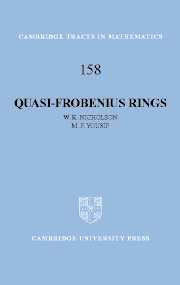Book contents
- Frontmatter
- Contents
- List of Symbols
- Preface
- 1 Background
- 2 Mininjective Rings
- 3 Semiperfect Mininjective Rings
- 4 Min-CS Rings
- 5 Principally Injective and FP Rings
- 6 Simple Injective and Dual Rings
- 7 FGF Rings
- 8 Johns Rings
- 9 A Generic Example
- A Morita Equivalence
- B Perfect, Semiperfect, and Semiregular Rings
- C The Camps–Dicks Theorem
- Questions
- Bibliography
- Index
B - Perfect, Semiperfect, and Semiregular Rings
Published online by Cambridge University Press: 14 September 2009
- Frontmatter
- Contents
- List of Symbols
- Preface
- 1 Background
- 2 Mininjective Rings
- 3 Semiperfect Mininjective Rings
- 4 Min-CS Rings
- 5 Principally Injective and FP Rings
- 6 Simple Injective and Dual Rings
- 7 FGF Rings
- 8 Johns Rings
- 9 A Generic Example
- A Morita Equivalence
- B Perfect, Semiperfect, and Semiregular Rings
- C The Camps–Dicks Theorem
- Questions
- Bibliography
- Index
Summary
The structure of a semisimple artinian ring is well known thanks to the Wedderburn–Artin theorem. Moreover, if R is right artinian then J is nilpotent and R/J is semisimple, so a major problem is to “lift” the structure of R/J to R. This leads to lifting idempotents and hence to the notion of a semiperfect ring. These rings are described in this section, together with a discussion of the important subclass of right perfect rings. Finally, the situation where R/J is regular is treated under the heading of semiregular rings. Each of these classes of rings is used extensively throughout the book.
Semiperfect Rings
Semiperfect rings are perhaps the most useful generaliz ation of the classical artinian rings. We begin by describing the simplest examples.
Proposition B.1.The following conditions are equivalent for a ring R:
R/J is a division ring.
R – J consists of units.
If a є R then either a or 1 – a is a unit.
R has a unique maximal right (respectively left) ideal.
J is a maximal right (respectively left) ideal.
Proof. (1)⇒(2) becausea is a unit in R whenever a + J is a unit in R/J, (2)⇒(3)⇒(4)⇒(5) are clear, and (5)⇒(1) because aR = R whenever a ∉ J by (5) because J ⊆sm RR.
A ring R is called local if it satisfies the conditions in Proposition B.1, and an idempotent e in R is called a local idempotent if eRe is a local ring. The following result will be used repeatedly.
- Type
- Chapter
- Information
- Quasi-Frobenius Rings , pp. 252 - 285Publisher: Cambridge University PressPrint publication year: 2003

